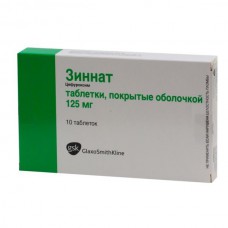Expiration date: 01/2026
Composition and form of issue:
Tablets, film-coated. 1 tablet contains:
cefuroxime (as cefuroxime axetil) 125mg, 250mg or 500 mg
in blistere 5 PCs in a carton 2 blisters.
Granules for preparation of suspension for oral administration, 5 ml contains:
cefuroxime (as cefuroxime axetil) 125mg or 250mg
excipients: stearic acid sucrose (3, 062 g) Tutti Frutti flavour 51.880/AP 05:50 Acesulfame potassium aspartame povidone K30 xanthan resin
in multi dose vials complete with measuring spoon and measuring Cup in a box 1 set.
Description of dosage form:
Tablets from white to almost white, film-coated, oval, biconvex, engraved on the one hand: for a dose of 125 mg — "GXES5", for a dose of 250 mg — "GXES7".
Pharmacological action:
Blocks synthesis of peptidoglycan of the cell wall of sensitive microorganisms.
Pharmacokinetics:
Quickly hydrolyzed in the intestinal mucosa to form cefuroxime and absorbed into the bloodstream (optimal absorption — after a meal). Cmax is 2-3 mg/l for doses of 125 mg and 4-6 mg/l for doses of 250 mg, observed after 2-3 h. T1/2 is 1-1. 5 h Associated with protein — 33-50%. Not metabolized, excreted by the kidneys. During dialysis, serum levels decrease.
Description of the pharmacological action:
Active against aerobic gram-positive microorganisms: Staphylococcus aureus, Streptococcus pneumoniae, Streptococcus pyogenes, etc. beta-hemolytic streptococci), Streptococcus group B (Streptococcus agalactiae) aerobic gram-negative microorganisms: Haemophilus fluenzae (incl. ampicillin-resistant strains), Haemophilus parainfluenzae, Moraxella catarrhalis, Escherichia coli, Klebsiella spp., Proteus mirabilis, Providencia spp., Proteus rettgeri, Neisseria gonorrhoeae (producing and non-producing penicillinase strains) anaerobic gram-positive and gram-negative microorganisms: Peptococcus spp., Peptostreptococcus spp., Clostridium spp., Bacteroides spp., Fusobacterium spp., Propionibacterium spp., as well as Borrelia burgdorferi. Spectrum of action includes strains resistant to ampicillin and amoxicillin (resistant to most beta-lactamases).
Indications:
Upper and lower respiratory tract infections (acute and chronic bronchitis, pneumonia) ear, throat and nose infections (otitis media, sinusitis, tonsillitis, pharyngitis) of the urinary tract (pyelonephritis, cystitis, urethritis) of the skin and soft tissues (furunculus, impetigo, pyoderma), gonorrhoea (acute gonococcal urethritis and cervicitis). Treatment (in the early stages) and prevention (late stages) Lyme disease in adults and children over 12 years.
Contraindications:
Hypersensitivity (including to other cephalosporins).
Application for pregnancy and breastfeeding:
With caution during pregnancy (especially in the early stages) and breast-feeding.
Side effect:
From the nervous system and sensory organs: headache.
From the cardiovascular system and blood (hematopoiesis, hemostasis): eosinophilia, positive reaction of Coombs, thrombocytopenia, leukopenia (sometimes severe), hemolytic anemia (very rare).
From the digestive tract: nausea, vomiting, diarrhea, increased activity of liver enzymes, pseudomembranous colitis (rare), jaundice.
From the skin: toxic epidermal necrolysis.
Allergic reactions: skin rash, urticaria, itching, drug fever, serum sickness, very rarely — anaphylaxis.
Drug interaction:
The combination with drugs that reduce the acidity of gastric juice, reduces bioavailability and prevents the increase of absorption associated with food intake.
Method of application and doses:
Inside, after eating. The standard course of therapy is about 7 days (from 5 to 10 days).
Adults:
| The majority of infections | 250 mg 2 times a day |
| Urinary tract infection | 125 mg 2 times a day |
| Mild to moderate lower respiratory tract infections such as bronchitis | 250 mg 2 times a day |
| More severe infections of the lower respiratory tract or suspected pneumonia | 500 mg 2 times a day |
| Pyelonephritis | 250 mg 2 times a day |
| Uncomplicated gonorrhea | A single dose of 1 g |
| Lyme disease in adults and children over 12 years | 500 mg 2 times a day for 20 days |
Sequential therapy
Pneumonia. Zinacef in a dose of 1, 5 g 2-3 times a day (in/in or/m) for 48-72 h, and then Zinnat orally at a dose of 500 mg 2 times a day for 7-10 days.
Exacerbation of chronic bronchitis. Zinacef, at a dose of 750 mg 2-3 times per day (in/in or/m) for 48-72 h, followed by treatment with Zinnat orally in a dose of 500 mg 2 times a day for 5-10 days.
The duration of parenteral and oral therapy is determined by the severity of the disease and the patient's condition.
Children:
| The majority of infections | 125 mg 2 times a day maximum to 250 mg / day |
| Otitis media or more severe infections in children aged 2 years and older | 250 mg 2 times a day, maximum up to 500 mg / day |
Zinnat tablets should not be crushed and therefore they are not suitable for the treatment of young children who cannot swallow an entire tablet. In children, it is better to use Zinnat suspension.
There are no data of clinical trials on the use of Zinnat in children under the age of 3 months.
In the treatment of infants and children, it is necessary to calculate the dose depending on body weight and age. In most infections, the dose for infants and children aged 3 months to 12 years is 10 mg/kg 2 times a day, but not more than 250 mg/day. With an average otitis media and more severe infections, the recommended dose is 15 mg/kg 2 times a day, but no more than 500 mg/day.
The tables below indicate the doses depending on the age and weight of the child for dosing the suspension Zinnat 125 mg/5 ml measuring spoons 5 ml, supplied in the package.
Dose at the rate of 10 mg/ kg, prescribed for most infections
| Age | Number of measuring spoons (5 ml) in one dose | ||
| 3 months-6 months | 4–6 | 40–60 | 1/2 |
| 6 months-2 years | 6–12 | 60–120 | 1/2–1 |
| 2 years-12 years | 12–>20 | 125 | 1 |
Dose at the rate of 15 mg/ kg, prescribed for moderate otitis media and more severe infections
| Age | Body weight, kg (approx.) | Single dose at admission 2 times a day, mg | Number of measuring spoons (5 ml) in one dose |
| 3 months-6 months | 4–6 | 60–90 | 1/2 |
| 6 months-2 years | 6–12 | 90–180 | 1–1/2 |
| 2 years-12 years | 12–>20 | 180–250 | 1 1/2–2 |
Preparation of the suspension
Shake the bottle vigorously a few times (for 1 min). Pour 20 ml of water (to the mark) into the measuring Cup. Pour the measured amount of water into the bottle and close the bottle cap. Flip the bottle over and shake it vigorously for 1, 5 minutes to mix the drug completely. Flip the bottle to its original position and shake vigorously.
Overdose:
When taking high doses, the Central nervous system and convulsions may be affected. Treatment-hemo-and peritoneal dialysis.
Precautionary measures:
With caution, patients with suspected Allergy to penicillins are prescribed. It should be borne in mind that the suspension is active for 10 days (stored at a temperature not exceeding 25 °C) the suspension prepared from sachets should be used immediately.




